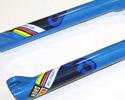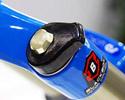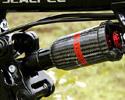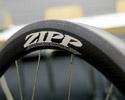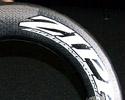
Recently on Cyclingnews.com |
Eurobike show
Germany, August 30-September 2, 2007
Main Page Previous Part Next Part
Part 2 - On Show: Eurobike 2007, August 30, 2007
Go fast goodies
By James Huang in Friedrichshafen, Germany
Score! Rock Shox launches new SID
|
|
|
After winning eight consecutive world championships and cranking out over half a million SID forks over its ten-year run, Rock Shox decided it was about time to put the kids to bed and wake up to a brighter morning. The new SID is (almost) here, and Rock Shox looks to have benefited from the lessons it has learned over the past few years.
Naturally, light weight was a key metric in the redesign, but engineers were not willing to sacrifice chassis rigidity goals or overall suspension performance in the process. As a result, the target 1450g weight for the production 2008 SID World Cup remains about the same as the existing model. Some may lament the lack of improvement in that area, but there certainly won't be any complaints about Rock Shox's claim that the new SID will boast overall stiffness on par with the current Reba World Cup.As we all expected, the new SID wears 32mm-diameter aluminum upper tubes matched to cast magnesium lower legs that sport Lyrik/Totem-like styling cues. In comparison to the similarly proportioned Reba, SID's stanchions are substantially shorter to minimize excess material. This allowed for correspondingly shorter damper and air spring shafts along with reduced oil volume, all of which shed grams. The shorter stanchion length also yields a hollow section at the bottom of each lower leg. This isn't all that important in and of itself, but it does allow for a more compact and rigid set of post mount disc tabs.
There is no carbon fiber steerer tube or crown, but with the newly optimized chassis, Rock Shox was apparently able to minimize the weight without resorting to more expensive (and somewhat more delicate) composite construction. Carbon fiber does make an appearance in the lower legs, however. The lower legs are wrapped in select areas to reinforce the structure, namely at the base of the arch and around the lower bushings to create a carbon fiber version of the reference Power Bulge.
SRAM will continue to use its proven spring and damper technology, but the usual plastic Motion Control spring tube is replaced with a lighter titanium version. The new compression assembly also uses a nearly identical low-speed compression circuit as on current Motion Control dampers, but now also includes a separate shimmed high-speed circuit for a more refined ride.
Both crown-mounted and remote lockout levers will be offered as with other Motion Control forks, but the new SID World Cup will exclusively offer a carbon fiber crown-mounted dial or a cleaner 'Nip/Tuck' remote cable spool design that neatly hides the end of the cable from view.Did we get to ride it? Sadly, no, but production forks will ship around February 2008 and we'll do our best to get our hands on a tester as soon as possible (or as soon as SRAM turns its head…).
Cannondale unveils Scalpel replacement
|
|
|
Like the Rock Shox SID, Cannondale's Scalpel has enjoyed a particularly successful run on the race circuit but was also rather long in the tooth and somewhat overdue for replacement. The new Cannondale Scalpel Carbon 100 answers that call with an all-new frame and an evolved rear suspension design.The new 'Zero Pivot Technology' design is somewhat of a misnomer as the shock is still actuated with a pivot-equipped linkage. Cannondale has managed to eliminate the dropout pivot altogether, though, by injecting the new carbon seat stay assembly with some carefully engineered flex through its length. Travel has now increased to a more capable 100mm courtesy of a longer flex section in the carbon chain stays, yet the chain stay length itself has actually dropped by 10mm for a tighter and more responsive rear end.
Cannondale says the new frame is not only 10% lighter than last year's already-light version, but also 15% stiffer. The improvement in rigidity is in some measure due to the new pseudo-pivotless construction, but a new carbon front triangle does its part as well. Cannondale adapted the same construction technology used in the road-going SystemSix for the new Scalpel Carbon 100, which incorporates a monocoque top tube/head tube/down tube section co-molded to an aluminum seat tube section.
A woven carbon fiber top sheet is nixed in favor of unidirectional plies exclusively, and all of the tubes are oversized in the usual Cannondale fashion. The down tube also sports the company's 'Power Pyramid' tapered shaping for better bottom bracket and torsional rigidity. Thanks to the frame's newfound rigidity, Cannondale says it was able to slacken the head tube angle slightly to 69.5° to yield a more stable personality without sacrificing overall responsiveness. Based on its in-house bottom bracket deflection tests, Cannondale also claims best-in-class stiffness-to-weight ratios for the new model.
Cannondale will equip the top-end Scalpel Carbon 100 with its 110mm-travel Lefty 110SL fork and recently updated Hollowgram SL integrated crankset. Complete chassis weight (including frame, fork, crankset, and headset) is listed at just 3665g; the complete top-end Scalpel Carbon 100 (without pedals) is said to weigh an astonishing 8.0kg (17.6lb).
For those with somewhat shallower pockets (it should go without saying that the 8kg version won't be cheap), Cannondale will equip the Scalpel Carbon 100 in several different versions, and another variant with an aluminum front triangle will be on tap as well.
Zipp 2008: better, faster, lighter, more!
Yikes, where to begin for this one. Zipp engineers have not only been burning the candle at both ends, but dousing it in the midnight oil, too, as the Indiana-based company will launch three new wheelsets, a new rear disc wheel, a new road crankset, and even some new components for the TT/Tri crowd for 2008.
Zipp says its thoroughly revamped 202 is the "first climbing wheel developed in the wind tunnel." Weight remains the same as last year at 1060g a pair, but the rim section depth has now grown to 32mm and also gains a more aerodynamic toroidal profile from last year's parabolic shape. In addition, Zipp also imparts the new 202 with its Aerodynamic Boundary Layer Control (ABLC) dimpled surface technology to yield a claimed energy savings of 4-6 watts as compared to last year's model.
The new 1080 is Zipp's deepest rim yet with a (surprise) 108mm-deep toroidal profile. According to Zipp, the 1080 is 29 seconds faster than a three-spoke wheel over 40km while also boasting an 80g weight advantage and the same crosswind handling characteristics in the process. More interestingly, Zipp also says the 1080 is actually faster than a disc wheel up to a 13° yaw angle.
Zipp probably meant to refer specifically to other manufacturer's disc wheels, though, as it also says its new Sub-9 disc achieves a negative drag figure when equipped with its updated Tangente2 dimpled tubular tire. According to Zipp, the Sub-9 produces -80g of drag at a 15° yaw angle, effectively yielding 11 watts of forward power. Shapewise, the Sub-9 almost looks to be an 808 toroidal rim blended with a small-diameter flat disc in the middle. Naturally, just about every surface on the Sub-9 is graced with Zipp's ABLC dimples.
All of Zipp's tubular carbon rims will now also incorporate reinforcing bands of Kevlar fibers stitched into both impact edges. This so-called Carbon Bridge technology is said to offer the most impact strength of any carbon rim construction and also improves lateral stiffness.
The Zipp 300 crankset and 175 bottom bracket combination was already among the lightest available while simultaneously offering amazing rigidity, but Zipp has apparently trumped itself with the new VumaQuad. At a claimed weight of just 560g (including bottom bracket, chainrings, and all hardware), the VumaQuad undercuts the 300/175 combo by 86g. Moreover, it also transitions to a more contemporary external bearing bottom bracket design for additional stiffness.In fact, Zipp says the VumaQuad is 33% stiffer than its next-lightest competitor. We can't confirm or refute that figure, but Zipp did manage to squeeze a giant 30mm-diameter aluminum spindle into a standard bottom bracket shell while also conforming to the new BB30 industry standard (anyone else thinking what we're thinking?).
The proprietary 110mm BCD 4-arm chainrings are supposedly stiffer than standard 130mm BCD 5-arm varieties, and one of the chainring bolts is integrated directly into the crankarm (for, guess what, more stiffness). Want more? The remaining three bolts feed in through the large chainring and thread directly into the inner ring, and chainrings will be offered in both 34/50T and 39/53T combinations.For the TT/Tri set, Zipp formerly introduced its new Vuka Bull carbon base bar (which we already covered back in July) as well as the new Vuka Shiftboss extensions and Vuka brake lever. The Vuka Shiftboss extensions cleverly integrate carbon fiber shifter mounts directly into the end of the bar. Although only available for Shimano levers, the extensions lop 80g from the usual setup and reduce shifter reach by 30mm for better ergonomics. Zipp also now offers its own full-carbon Vuka Brake Levers which hit the scale at just 100g per pair.
Zipp's price-conscious Flashpoint wheel line continues on for 2008 with the introduction of a new FP80 wheelset. Taiwan-made hubs are laced with custom bladed Sapim stainless steel spokes to 82mm-deep aluminum-and-carbon fiber clincher rims. Zipp says the FP80 is more aero than a three-spoke wheel and offers better handling and ride quality, but the reasonable cost clearly carries a penalty at the scale; claimed weight for the pair is 2121g.
Photography
For a thumbnail gallery of these images, click here
Images by James Huang/Cyclingnews.com
- The new SID is here!
- It was a nice run for sure for the old SID , but the new SID will be most welcome.
- The previous generation lower legs look absolutely anemic in comparison.
- The new lower legs are mostly cast magnesium…
- …but are also strategically wrapped in carbon fiber to reinforce critical areas.
- Production versions will leave just a few teaser windows to remind you what lies beneath that characteristic blue hue.
- Shorter stanchion tubes yield a sizeable hollow in the bottom of each lower leg.
- The extra real estate allowed for a more compact and stiffer disc brake mount.
- Even the rebound adjuster is hollow!
- Yes, HB, there's really nothing in there.
- Last year's carbon fiber upper assembly has been replaced by a conventional aluminum steerer tube and low-profile forged aluminum crown.
- The top-level SID World Cup will offer an exclusive 'Nip/Tuck' remote cable spool for a cleaner appearance.
- The SID World Cup guts are essentially based on current technologies, but further tweaks refine the ride and cut weight.
- The original red plastic spring tube will be replaced with a titanium piece in the new SID.
- Exclusive to SID is a new carbon fiber crown-mounted lockout dial.
- Hmm, what are these threaded holes for? For the yet-to-be-shown integrated fender, of course.
- New machined aluminum air valve caps offer a distinct look.
- Anyone else remember this guy from the original launch? It's much creepier-looking in 3D.
- The new Scalpel 100 is both lighter and stiffer than the current version.
- The new rear end does away with dropout pivots entirely.
- A short aluminum linkage drives the DT Swiss rear shock.
- The new carbon fiber chain stays have a longer flattened section to provide more travel.
- Chain stays are reinforced with a small aluminum bridge.
- The carbon stays are bonded to aluminum dropouts.
- The new Zipp 202 grows in section depth to 32mm…
- …and also gains a wind-cheating dimpled surface.
- The new Zipp 1080 is supposedly even faster than a full disc in certain conditions.
- Zipp's new Sub-9 rear disc wheel is said to actually be capable of producing negative drag.
- The VumaQuad is an ultralight road crankset that Zipp says is also super stiff.
- A 24mm Dura-Ace spindle actually fits inside the 30mm VumaQuad spindle.
- Everywhere you look, it's the same thing : big, big, and big.
- Chainring bolts cleverly thread directly into the inner chainring.
- Shimano-compatible shifter mounts are directly integrated into the ends of the Vuka Shiftboss extensions.
- Zipp's value-oriented Flashpoint line gains a new FP80 model.
- Flashpoint hubs are made in Taiwan , but include higher quality Zipp-specified Japanese bearings.

